

Designing Style Guidelines For Brands And Websites. Advertisement A website is never done.
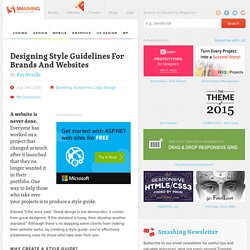
Everyone has worked on a project that changed so much after it launched that they no longer wanted it in their portfolio. One way to help those who take over your projects is to produce a style guide. Edward Tufte once said: “Great design is not democratic; it comes from great designers. If the standard is lousy, then develop another standard.” Why Create A Style Guide? You’ll have an easy guide to refer to when handing over the project.Makes you look professional. Branding Guidelines: What To Include? Strategic Brand Overview This should be short and sweet. 1See Kew’s branding guidelines2. Kew uses strong photography in its “brand essence” message, with a few paragraphs that both inspire and define the brand. Logos For print and Web, most brands revolve around the logo. Ernment 2.0 planning and governance - Web Guide. Engaging online, whether internally or publicly, will consume time, expend resources and potentially raise issues which are best answered by having clear internal social media guidelines and/or governance arrangements for online engagement initiatives.
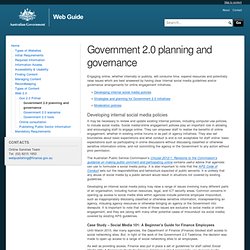
Developing internal social media policies. YourHealth - About this website. This website allowed Australians to provide their views to the Australian Government about options to improve the health system.
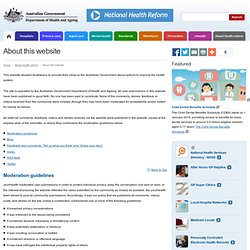
The site is operated by the Australian Government Department of Health and Ageing. All user submissions in this website have been published in good faith. No one has been paid to contribute. None of the comments, stories, feedback or videos received from the community were scripted (though they may have been moderated for acceptability and/or edited for brevity as below). All external comments, feedback, videos and stories received via the website were published in the website, except at the express wish of the submitter, or where they contravene the moderation guidelines below. About this Blog. This blog is where we write about what is happening here at the Memorial.

Topics will cover the exhibitions we are working on and what we are doing with items in our collections. There will be stories about people, places, events and objects, or reports from battlefield tours. The blog is written by staff from across the Memorial, which is why you will find a broad range of topics here. The views expressed in the blog are those of the authors, and do not necessarily reflect the view of the Memorial. We hope you will stay and explore, and join in the conversation. Comments We welcome your comments on the posts in our blog. We do review the comments, and will delete any that we judge to be inappropriate. Privacy When you register to post a comment, we will not use the email address you provide us unless you ask us to do so.
Contact If you have a question that is not directly related to a post in the blog, please email webmaster@awm.gov.au. Govspace. Moderation policy and process. Ernment 2.0 planning and governance - Web Guide. Engaging online, whether internally or publicly, will consume time, expend resources and potentially raise issues which are best answered by having clear internal social media guidelines and/or governance arrangements for online engagement initiatives.
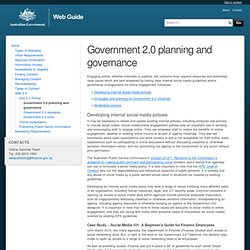
Developing internal social media policies It may be necessary to review and update existing internal policies, including computer-use policies, to include social media. Social media/online engagement policies play an important role in allowing and encouraging staff to engage online. They can empower staff to realise the benefits of online engagement, whether in existing online forums or as part of agency initiatives. The Australian Public Service Commission’s Circular 2012/1: Revisions to the Commission’s guidance on making public comment and participating online contains useful advice that agencies can use to formulate a social media policy.
Case Study – Social Media 101: A Beginner’s Guide for Finance Employees. Handing comments over to Facebook is a double-edged sword. When Facebook launched the ability to embed Facebook comments on third-party websites, a lot of publishers saw it as a life-saver: not only would it improve traffic by exposing their content to others on the social network, but Facebook’s “real names” policy would also cut down on trolling and bad behavior.
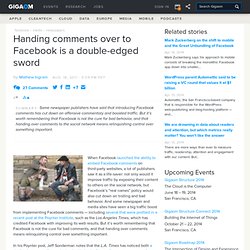
And some newspaper and media sites have seen a big traffic boost from implementing Facebook comments — including several that were profiled in a recent post at the Poynter Institute, such as the Los Angeles Times, which has credited Facebook with improving its web results. But it’s worth remembering that Facebook is not the cure for bad comments, and that handing over comments means relinquishing control over something important. In his Poynter post, Jeff Sonderman notes that the L.A. Contingency Theories. Influences of internal and external constraints in organizations History and Orientation To be added.
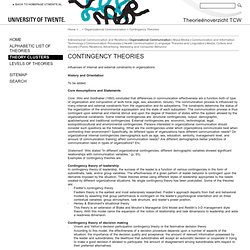
Core Assumptions and Statements Core: Wiio and Goldhaber (1993) concluded that differences in communication effectiveness are a function both of type of organization and composition of work force (age, sex, education, tenure). The communication process is influenced by many internal and external constraints from the organization and its subsystems. Statement: Wiio stated “In different organizational contingencies, different demographic variables showed significant relationships with communication variables.”
Ntingency plans.